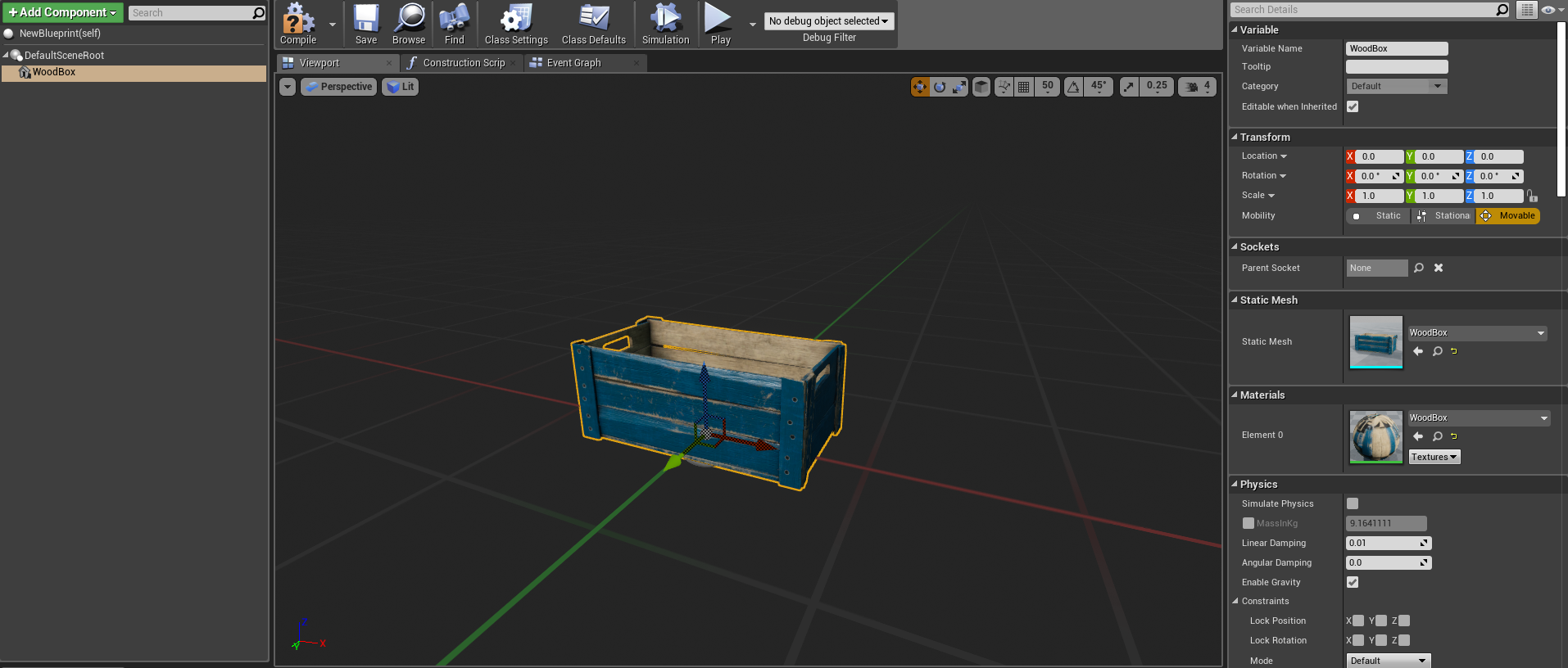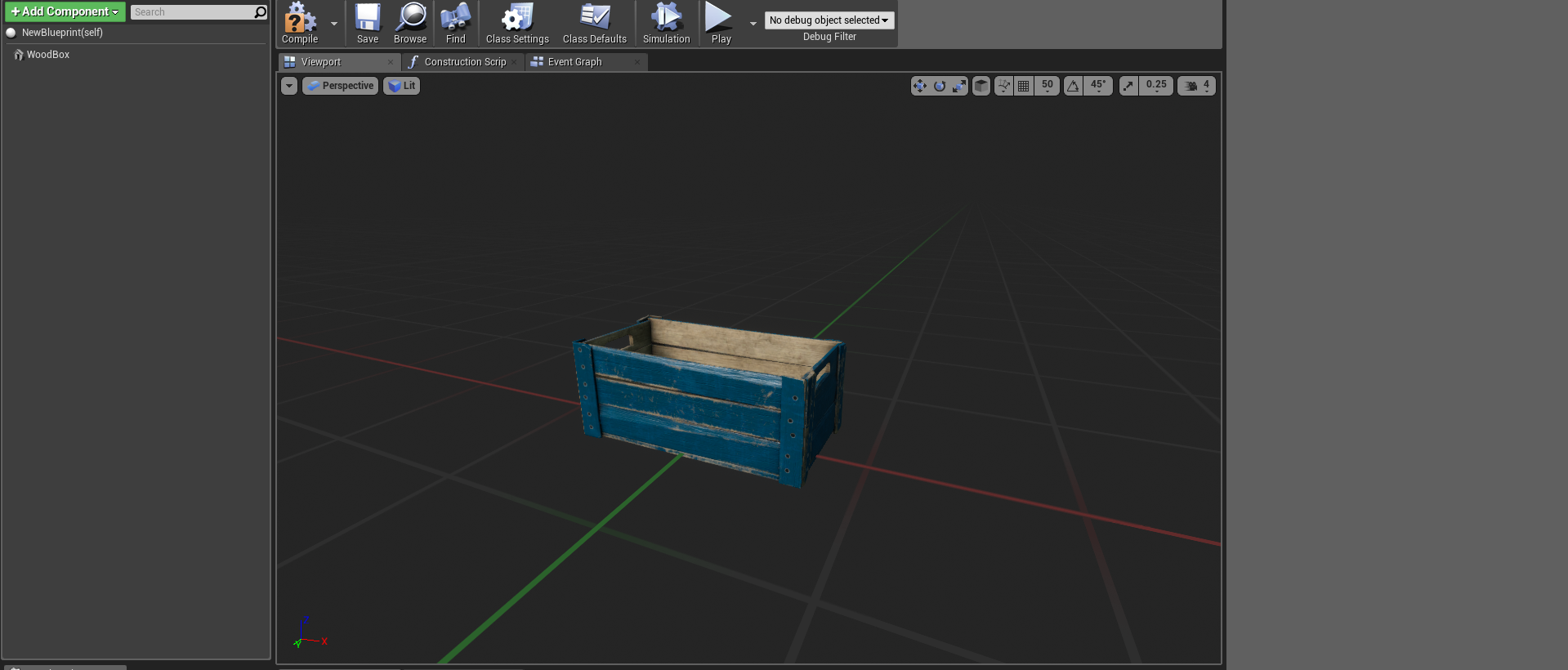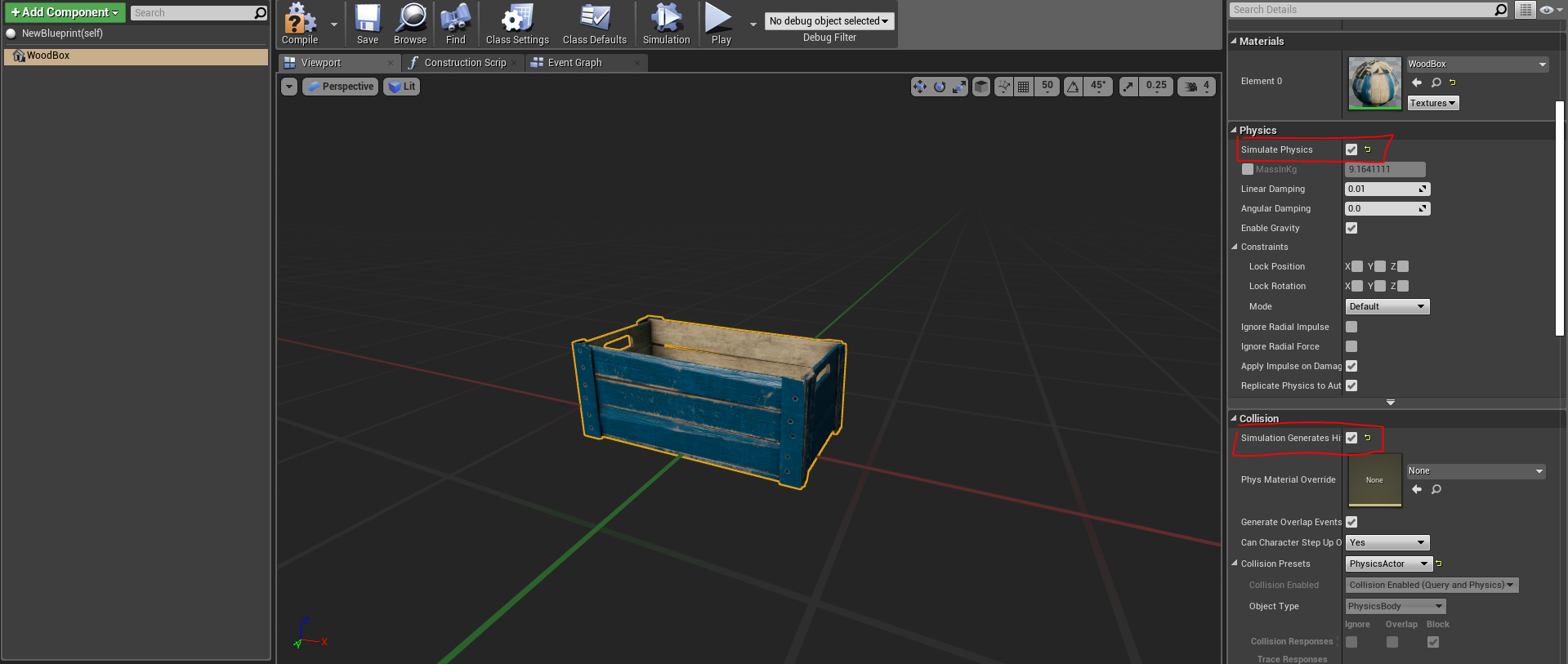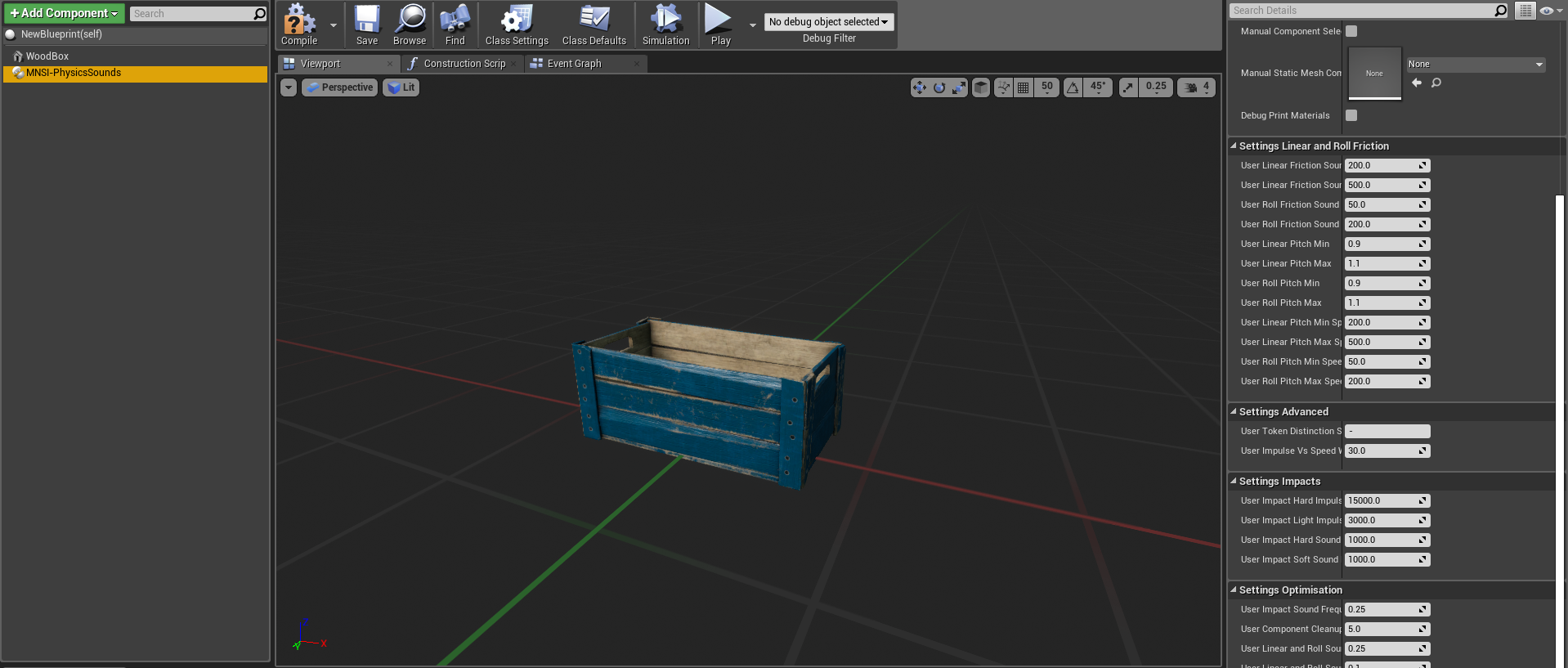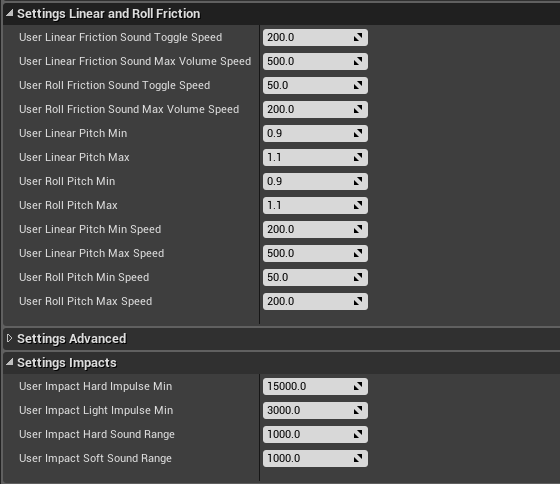Difference between revisions of "MNSI:Quick Start"
| (5 intermediate revisions by the same user not shown) | |||
| Line 1: | Line 1: | ||
[[Category:MNSI]]This guide will detail the simplest form of operation. Adding a single MNSI component to a blueprint actor. | |||
__TOC__ | |||
== | ==The How== | ||
It is recommended that the first time, this guide be followed using one of the example meshes supplied. That way all external parameters that could cause headaches will be removed while still learning the workings of this plugin. Let's use "MNSI-MainPlugin > Examples > Props > mesh > WoodBox" | |||
{|class=wikitable | |||
| style="padding: 10px" | | |||
Quick Run; | |||
# Make new blueprint actor. | |||
# Add Static Mesh Component. | |||
# Set Mesh as root. | |||
# Set "Simulate Physics" and "Generate Hit Events" on mesh. | |||
# Add "MNSI-PhysicsSounds" as component. | |||
|} | |||
===Illustrated!=== | |||
* Make new blueprint class -> actor | |||
[[File:Setup1.PNG]] | |||
* Either drag the mesh needed, or use Add Component and create a new Static Mesh Component. Here is how it looks like using the example WoodBox mesh. | |||
[[File:Setup2.PNG]] | |||
* ((Optional but recommended)) Set your mesh as Root. Click on it and drag it over the Default Scene Root. It should look like this. | |||
[[File:Setup3.PNG]] | |||
* Enable "Simulate Physics" and "Generate Hit Events" on mesh. | |||
[[File:Setup5.PNG]] | |||
* Either drag MNSI-PhysicsSounds or add it though Add Component. MNSI-PhysicsSounds is located in "MNSI-MainPlugin" | |||
[[File:Setup6.PNG]] | |||
* Done. | |||
==Adjusting the parameters== | |||
The default plugin settings will not apply for every prop. The most important factor being your prop's physical mass. Really light weight props need settings different than really heavy props. | |||
The settings you care about are as imaged. | |||
[[File:Tutorial LinearAndRollSettingsExample.PNG]] | |||
User Impact Hard Impulse Min - Defines the minimum impulse to play a hard impact sound. | |||
User Impact Light Impulse Min - Defines the minimum impulse to play a light impact sound. | |||
The | The Sound Range for both Hard and Light impacts is an impulse value added to the minimum impulse needed to create a sound volume range. | ||
For example; | |||
---- | |||
User Impact Hard Impulse Min = 1000 | |||
User Impact Hard Sound Range = 0 | |||
This means that as soon as the prop experiences an impulse larger or equal to 1000, a hard impact sound will play at full volume all the time. | |||
---- | |||
User Impact Hard Impulse Min = 1000 | |||
User Impact Hard Sound Range = 1000 | |||
This now means that; | |||
an impulse of 1000 will play a sound with 0 volume; | |||
an impulse of 1500 will play a sound with 0.5 volume; | |||
an impulse of 2000 will play a sound with 1 volume. | |||
User Impact Hard Sound Range is added to User Impact Hard Impulse Min. | |||
---- | |||
It is mostly a trial and error until the best values are found. | |||
Outlined here is the best practice method for quickly finding the best values for a prop. | |||
Let's start with Settings Impacts. A large Min value will need a really fast speed or heavy mass prop to trigger a sound. And a low Min value can end up triggering a sound even when the prop is stationary. A good approach is to adjust the Light and Hard impact values one at a time. So setting User Impact Hard Impulse Min to let's say 1000000 would effectively disable Hard impacts and allow you to focus on finding a value for User Impact Light Impuse Min that triggers at reasonable velocities. Once that is done, bring down the Hard Min to a value that's larger than the other value. | |||
Rolling and Friction sounds are a bit more Catchall. Get a slippery surface to experiment with good friction sounds and use spheres with similar mass to experiment with good rolling values. | |||
Latest revision as of 19:04, 6 June 2019
This guide will detail the simplest form of operation. Adding a single MNSI component to a blueprint actor.
The How
It is recommended that the first time, this guide be followed using one of the example meshes supplied. That way all external parameters that could cause headaches will be removed while still learning the workings of this plugin. Let's use "MNSI-MainPlugin > Examples > Props > mesh > WoodBox"
|
Quick Run;
|
Illustrated!
- Make new blueprint class -> actor
- Either drag the mesh needed, or use Add Component and create a new Static Mesh Component. Here is how it looks like using the example WoodBox mesh.
- ((Optional but recommended)) Set your mesh as Root. Click on it and drag it over the Default Scene Root. It should look like this.
- Enable "Simulate Physics" and "Generate Hit Events" on mesh.
- Either drag MNSI-PhysicsSounds or add it though Add Component. MNSI-PhysicsSounds is located in "MNSI-MainPlugin"
- Done.
Adjusting the parameters
The default plugin settings will not apply for every prop. The most important factor being your prop's physical mass. Really light weight props need settings different than really heavy props.
The settings you care about are as imaged.
User Impact Hard Impulse Min - Defines the minimum impulse to play a hard impact sound. User Impact Light Impulse Min - Defines the minimum impulse to play a light impact sound.
The Sound Range for both Hard and Light impacts is an impulse value added to the minimum impulse needed to create a sound volume range.
For example;
User Impact Hard Impulse Min = 1000 User Impact Hard Sound Range = 0
This means that as soon as the prop experiences an impulse larger or equal to 1000, a hard impact sound will play at full volume all the time.
User Impact Hard Impulse Min = 1000 User Impact Hard Sound Range = 1000
This now means that; an impulse of 1000 will play a sound with 0 volume; an impulse of 1500 will play a sound with 0.5 volume; an impulse of 2000 will play a sound with 1 volume.
User Impact Hard Sound Range is added to User Impact Hard Impulse Min.
It is mostly a trial and error until the best values are found.
Outlined here is the best practice method for quickly finding the best values for a prop.
Let's start with Settings Impacts. A large Min value will need a really fast speed or heavy mass prop to trigger a sound. And a low Min value can end up triggering a sound even when the prop is stationary. A good approach is to adjust the Light and Hard impact values one at a time. So setting User Impact Hard Impulse Min to let's say 1000000 would effectively disable Hard impacts and allow you to focus on finding a value for User Impact Light Impuse Min that triggers at reasonable velocities. Once that is done, bring down the Hard Min to a value that's larger than the other value.
Rolling and Friction sounds are a bit more Catchall. Get a slippery surface to experiment with good friction sounds and use spheres with similar mass to experiment with good rolling values.

